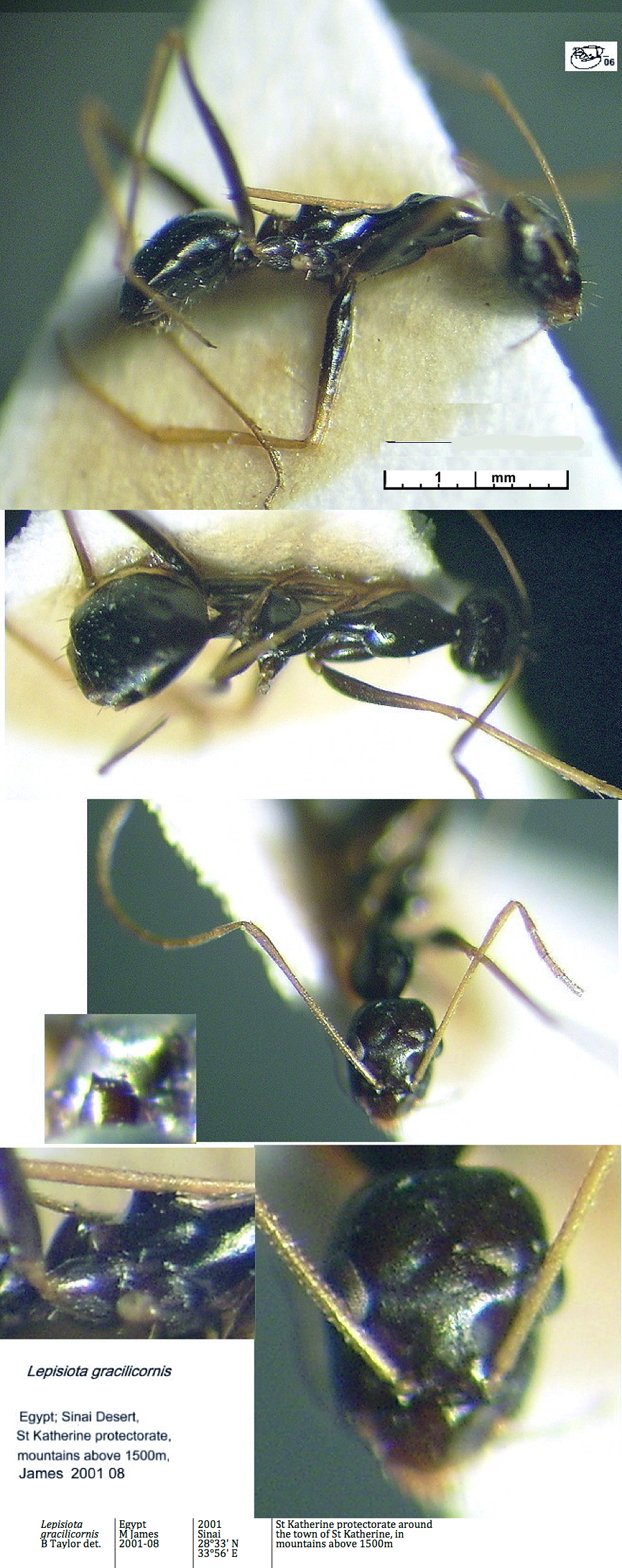Lepisiota gracilicornis (Forel)
 Type location Yemen (Acantholepis
gracilicornis n. sp., Forel, 1892a: 42, in key, worker; Emery,
1893f: 257, queen) collected at Aden by Dr F. Ris - see below Type location Yemen (Acantholepis
gracilicornis n. sp., Forel, 1892a: 42, in key, worker; Emery,
1893f: 257, queen) collected at Aden by Dr F. Ris - see below
race abdominalis
(Acantholepis gracilicornis
Forel, r. abdominalis, n.
st., Forel, 1894b: 73, worker) from Ethiopia, collected at
Südabessinien by Ilg - see http://www.antweb.org/specimenImages.do?code=casent0909891
worker and queen only described  . .
|
Forel's (1892a) description is on  . Emery's (1893f) description of the queen
is on . Emery's (1893f) description of the queen
is on  . Forel's (1894b)
description of abdominalis is on . Forel's (1894b)
description of abdominalis is on  . .
|
 The photomontage of the
holotype worker is collated from http://www.antweb.org/specimen.do?name=casent0249898 The photomontage of the
holotype worker is collated from http://www.antweb.org/specimen.do?name=casent0249898
|
Oxford University Museum
specimens
Lepisiota gracilicornis
B Taylor det.
|
Egypt
M James
2001-08
|
2001
Sinai
28°33' N
33°56' E
|
St Katherine
protectorate around the town of St Katherine, in mountains above 1500m
|
3
|
 |
Lepisiota gracilicornis
B Taylor det.
|
Egypt
J Kugler
|
16.ii.1981
Assuan
|
.
|
1
|
|
Lepisiota gracilicornis
B Taylor det.
|
Egypt
J Kugler
|
15.ix.1977
Sinai
Wadi Tineh |
|
1
|
|
Lepisiota gracilicornis
B Taylor det. |
Egypt
J Kugler |
24.iii.1969
Sinai
Wadi Natzeb
|
|
1
|
|
|
 The
photomontage is of a worker collected in the Sinai Desert, Egypt,
St Katherine protectorate around the town of St Katherine, in mountains
above 1500m, in early 2001, by Mike James, a research student of
Francis Gilbert. Collingwood (1985) described the species as from the
Middle East, Arabia, "very long appendages, long thin alitrunk and
brilliantly shining integument", with antennal scapes twice as long as
head width. These Sinai specimens match Forel's original description
and the scapes surpass the occiput by 2/3 their own length, SI (i.e
SL/HW) = 240. It seems from this that the separation in Collingwood
& Agosti (1996) is wrong and, hence, their definition of a separate
species, Lepisiota riyadha is questionable. What seems to be
true is that the species shows variable worker size within the same
colony. The
photomontage is of a worker collected in the Sinai Desert, Egypt,
St Katherine protectorate around the town of St Katherine, in mountains
above 1500m, in early 2001, by Mike James, a research student of
Francis Gilbert. Collingwood (1985) described the species as from the
Middle East, Arabia, "very long appendages, long thin alitrunk and
brilliantly shining integument", with antennal scapes twice as long as
head width. These Sinai specimens match Forel's original description
and the scapes surpass the occiput by 2/3 their own length, SI (i.e
SL/HW) = 240. It seems from this that the separation in Collingwood
& Agosti (1996) is wrong and, hence, their definition of a separate
species, Lepisiota riyadha is questionable. What seems to be
true is that the species shows variable worker size within the same
colony.
|
 The
photomontage is of specimens collected in Sudan, at Afad (South
Ad Damazin), 11°46'0"N 34°21'0"E, by Awatif Omer, 2009. The
photomontage is of specimens collected in Sudan, at Afad (South
Ad Damazin), 11°46'0"N 34°21'0"E, by Awatif Omer, 2009.
|
|